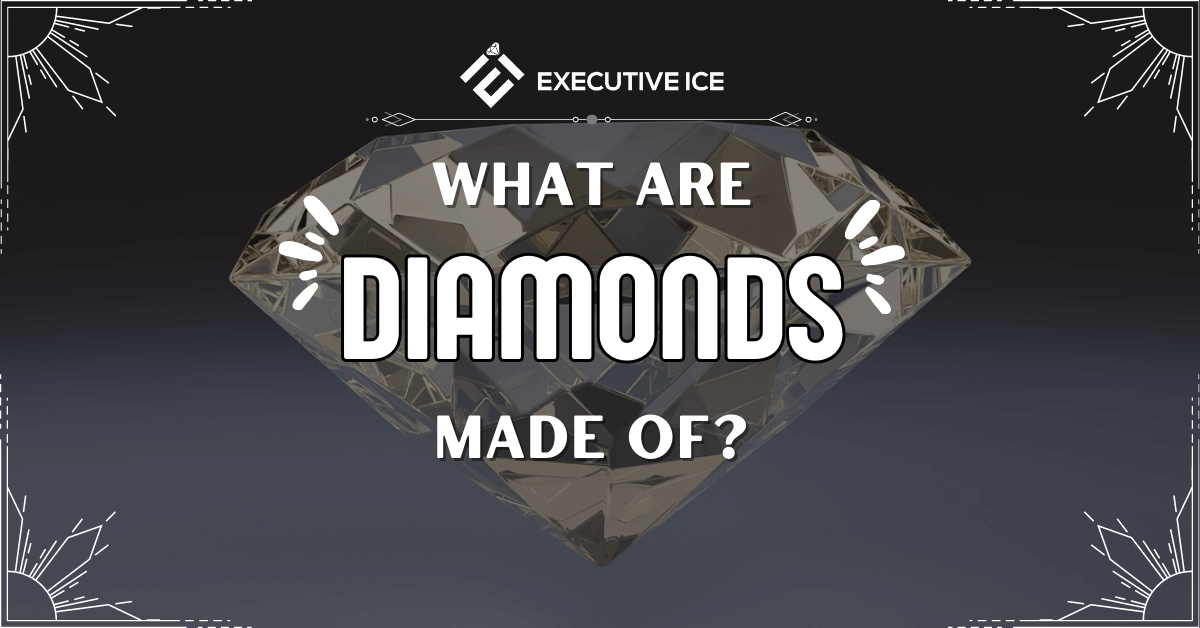Regarded as tokens of love, status, and luxury, diamonds are a marvel of nature’s capacity for stunning beauty.
Yet, we must have once wondered what are diamonds made of. what lies beneath their glittering surfaces? At their core, diamonds are essentially an assembly of carbon atoms, interlinked in a tightly-knit lattice that grants them their famous hardness and durability.
Three Essential Factors: Heat, Pressure, and Time
The genesis of a diamond takes place beneath the surface of the Earth, in its mantle, and requires a perfect blend of three critical elements: heat, pressure, and time.
Over billions of years, extreme heat and pressure compress carbon atoms, forging them into diamonds. These diamonds then journey to the Earth’s surface due to geological activities like volcanic eruptions or tectonic plate shifts. Occasionally, diamonds are also the result of intense heat and pressure generated by asteroid impacts.
Diamonds crave an intense environment for their formation, requiring temperatures of at least 752°F (400°C). The ideal setting for diamond growth lies approximately 160 kilometers below the Earth’s crust, where both heat and pressure conditions are optimal.
How are Colored Diamonds Made?
Though colorless diamonds are perhaps the most recognized and highly sought after, diamonds come in a kaleidoscopic range of hues, including black, blue, and purple. More & more top diamonds retailers are offering colored diamonds beside their collections of colorless stones.
The appearance of these captivating colors is due to mineral impurities or structural deformities within the diamond’s crystalline lattice:
1. Purple Diamonds: The enchanting hue of purple diamonds arises from the presence of plastic deformation, an abnormality in the crystal structure caused by intense heat and pressure.
2. Black Diamonds: Also known as Carbonado diamonds, these intriguingly dark gems owe their color to numerous minute inclusions of graphite and other minerals.
3. Blue Diamonds: The breath-taking blue tint seen in diamonds like the famous Hope Diamond comes from the presence of boron impurities within the diamond structure. The higher the boron content, the deeper the blue.
4. Yellow Diamonds: The beautiful sunny hue of yellow diamonds is a result of the presence of nitrogen molecules. These molecules absorb blue light, making the diamond appear yellow to the human eye. The more nitrogen present, the more intense the yellow color will be.
5. Pink Diamonds: The exact cause of pink diamonds’ lovely blush remains a mystery to scientists. However, one popular theory is that they acquire their pink hue from a process known as ‘plastic deformation.’ This process refers to the intense pressure and heat that alter the diamond’s crystal lattice while it’s still forming in the earth, leading to selective absorption of light and consequently producing a pink color.
6. Red Diamonds: Like pink diamonds, red diamonds are believed to get their intense color from plastic deformation. They are incredibly rare, with the Moussaieff Red Diamond being one of the most famous examples, weighing just over 5 carats.
7. Green Diamonds: Natural green diamonds owe their color to radiation exposure. The diamond’s proximity to naturally radioactive rocks during its formation causes the diamond to absorb radiation, which impacts the stone’s atomic structure and leads to the green hue. Note that this color is usually restricted to the surface, and may be lost during the cutting and polishing process.
8. Brown Diamonds: Brown diamonds, sometimes referred to as ‘chocolate diamonds’, get their color from structural defects that occur during their formation. These defects, known as ‘graining,’ absorb light in a specific pattern, resulting in a brown color.
9. Gray Diamonds: Gray diamonds get their color from the presence of hydrogen or from inclusions that cause the diamond to appear gray. They may also appear gray due to the way the diamond’s crystal lattice has been deformed, which affects how light passes through the stone.
From the fiery depths of the Earth’s mantle to the showcasing in luxurious jewelry, the journey and composition of diamonds is a tale of extraordinary beauty and resilience. With their unyielding structure and captivating range of colors, diamonds continue to charm us with their shimmering allure.
What About Lab-Grown Diamonds?
Amid the lofty prices of naturally occurring diamonds, scientists devised innovative methods to synthesize these sparkling gemstones within the confines of a laboratory.
The origins of lab-grown diamonds can be traced back to the 1950s when a group of geologists and researchers from Sweden and the United States made a groundbreaking discovery. They found a way to create diamonds by transforming graphite and molten iron.
While these laboratory-cultivated diamonds don’t originate from the Earth’s mantle, they utilize a strikingly similar process for their creation. They harness the trio of high temperatures, intense pressure, and carbon, which are integral elements in the formation of natural diamonds.
Lab-grown diamonds possess a unique allure; they bear no visible difference from their naturally formed counterparts, yet are significantly more affordable, offering an attractive alternative. In recent years, their popularity has surged, with prices generally falling 30-40% below those of earth-mined diamonds.
These diamonds are birthed through a process that incorporates either natural or laboratory-generated diamond seeds. Scientists utilize these seeds as templates to create precise replicas of authentic, naturally formed diamonds. The introduction of heat, pressure, and chemical vapor deposition subsequently lead to the formation of the diamond.
One intriguing facet of lab diamonds is their swift formation. Instead of the billions of years required to form a natural diamond, lab diamonds emerge in a matter of weeks. This expedited process is a key advantage of lab-grown diamonds, allowing for increased market supply without the influence of single company dominance (hint, De Beers).
Lab-grown diamonds also champion ethical production. They’re cultivated in laboratories, bypassing the risk of conflict associations that occasionally plague the market of natural diamonds.
Regardless of their origin—be it in a lab or deep within the Earth—both types of diamonds utilize the same foundational elements: carbon, heat, pressure, and time.
Each offers its own appeal, with lab-grown diamonds providing an ethical, affordable alternative to their naturally formed counterparts.
How Are Diamonds Formed
Numerous studies on ancient diamonds have yielded compelling evidence that these remarkable gemstones were formed long before any vegetation graced our planet. It’s believed that they came into existence during the pre-Cambrian period, an era predating plant life on Earth.
Interestingly, diamonds are typically found approximately 150 kilometers below the Earth’s surface, while coal generally forms at depths of merely 4 kilometers.
A couple of leading theories have been proposed to shed light on the fascinating process of natural diamond formation:
1. Formation in the Earth’s Mantle
Nestled about 150 kilometers beneath the Earth’s crust, the mantle provides a conducive environment for the creation of diamonds. The potent combination of temperatures reaching around 1200 degrees Fahrenheit (about 1050 degrees Celsius) and immense pressures serves as the perfect catalyst for transforming carbon-rich rock into gleaming diamonds.
Following their formation, these diamonds are catapulted to the Earth’s surface via powerful volcanic eruptions. This process contributes the majority of diamonds destined for the global commercial market. It’s worth noting, however, that the specific combination of temperature and pressure required for diamond formation is exclusive to selected regions worldwide.
2. Formation on Subduction Zones
Diamonds also form when tectonic plates are driven deep into the Earth’s surface and then resurface. As the plate delves deeper, it creates a high-pressure environment conducive to diamond formation.
This process can occur at depths as shallow as 60 kilometers beneath the Earth’s surface, requiring temperatures of approximately 390 degrees Fahrenheit (200 degrees Celsius). Oceanic plates are particularly susceptible to this subduction, given their higher density.
Intriguingly, this process sheds light on why diamonds unearthed in Brazil bear properties reminiscent of oceanic crust. However, diamonds formed in this manner tend to be exceedingly tiny and are not typically used for commercial purposes.
3. Asteroid Influence
The colossal impact of an asteroid striking Earth creates a crater while simultaneously generating extreme temperature and pressure. The pressure escalates significantly due to the astronomical speed at which the asteroid travels.
The energy unleashed from such an impact equates to the force of multiple nuclear weapons, and the ensuing temperature surpasses that of the sun’s surface. However, the presence of carbon-rich rock at the impact site is a necessary condition for diamond creation.
This explains why, despite asteroids bombarding the Earth for millions of years, diamonds have only been discovered in a handful of locations.
4. Diamonds From Space
During the dissection of the famed Allen Hills meteorite, a plethora of nano-diamonds was discovered. As meteorites voyage through the cosmos, collisions among them and with other objects create substantial pressure.
Furthermore, meteorites carry carbon and maintain high internal heat, thereby offering an ideal environment for diamond formation. However, these outer-space diamonds are not viable for commercial use and are typically utilized as a diamond material source.
Concluding Insights: Understanding What Are Diamonds Made Of
In summary, diamonds are formed from carbon atoms undergoing extreme heat, pressure, and over the course of billions of years.
These dazzling stones journey to the Earth’s surface via volcanic eruptions or natural movements of the Earth’s tectonic plates.
Lab-grown diamonds, while formed in a controlled environment rather than under natural circumstances, are visually indistinguishable from their naturally formed counterparts.
Diamonds, with their rarity, captivating beauty, and mesmerizing sparkle, are truly a unique treasure of the Earth.
Now that you have delved deeper into understanding ‘what are diamonds made of and how they are formed,’ you’ll gain a greater appreciation for the origins of your precious gemstone.
As a next step, consider learning about how to make informed decisions when purchasing diamonds.




